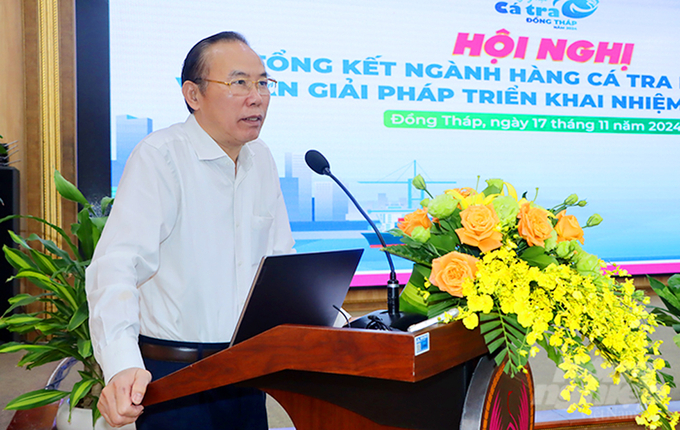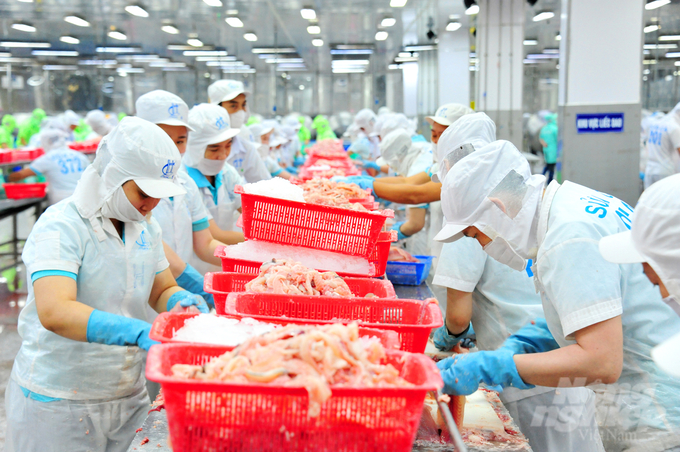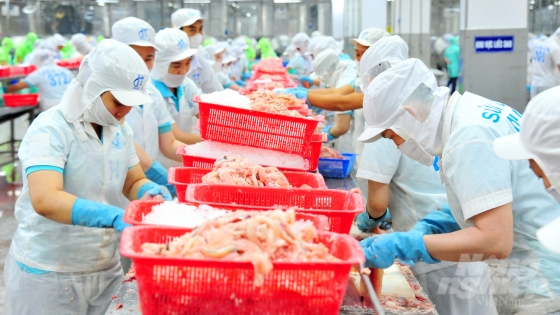(VAN) Vietnam has set a goal to enhance the value of the catfish industry by 2025, aiming for a production output of 1.65 million tons and an export turnover of around 2 billion USD.

Deputy Minister of Agriculture and Rural Development Phung Duc Tien delivered a speech directing the development of the catfish industry for the year 2025. Photo: Le Hoang Vu.
As part of the “Dong Thap catfish festival 2024”, on November 17th, the Ministry of Agriculture and Rural Development (MARD) in collaboration with the People’s Committee of Dong Thap Province organized the conference “Review of the catfish industry in 2024 and discussing solutions for implementing tasks in 2025”.
Mr. Nguyen Phuoc Thien, Vice Chairman of the People’s Committee of Dong Thap Province, said that catfish is considered a key product of Vietnam in general and the Mekong Delta region in particular. In recent years, people in the Mekong Delta have developed catfish farming to a new level, with the formation of large farms and the application of scientific and technological advances in many professional farming areas.
In 2024, the catfish farming industry in Dong Thap Province remained relatively stable, with the sector’s production value continuing to grow. It is estimated that the total production value for the catfish industry will reach over 365 million USD, marking a 2.86% increase compared to 2023. This accounts for more than 17% of the total agricultural, forestry, and fishery production value of the province. The area dedicated to commercial catfish farming has expanded to 2,630 hectares, with an estimated production output of 540.000 tons – an increase of 15.000 tons compared to the previous year.
Regarding the consumption of catfish, the market in Dong Thap remains relatively stable. The price for commercial catfish (weighing 0.7 – 0.8 kg/fish) fluctuates between 1 and 1.1 USD/kg. At the same time, production costs have decreased, largely due to a reduction in feed prices, which has allowed farmers to generate profits. Currently, Dong Thap has 902 facilities engaged in the production and nursing of catfish fry, which includes 52 hatcheries and 850 nurseries. It is estimated that by the end of 2024, the province will have produced 17 billion catfish fry and 1.3 billion juvenile catfish.
In 2024, the catfish farming industry in Dong Thap Province remained relatively stable, with the sector’s production value continuing to grow. It is estimated that the total production value for the catfish industry will reach over 365 million USD, marking a 2.86% increase compared to 2023. This accounts for more than 17% of the total agricultural, forestry, and fishery production value of the province. The area dedicated to commercial catfish farming has expanded to 2.630 hectares, with an estimated production output of 540.000 tons – an increase of 15.000 tons compared to the previous year.
Regarding the consumption of catfish, the market in Dong Thap remains relatively stable. The price for commercial catfish (weighing 0.7 – 0.8 kg/fish) fluctuates between 1 and 1.1 USD/kg. At the same time, production costs have decreased, largely due to a reduction in feed prices, which has allowed farmers to generate profits. Currently, Dong Thap has 902 facilities engaged in the production and nursing of catfish fry, which includes 52 hatcheries and 850 nurseries. It is estimated that by the end of 2024, the province will have produced 17 billion catfish fry and 1.3 billion juvenile catfish.

Deputy Minister of Agriculture and Rural Development Phung Duc Tien recommended that ministries, sectors, and localities should develop catfish breeds in an industrial direction, with large-scale production. Photo: Le Hoang Vu.
Mr. Nguyen Phuoc Thien emphasized that the catfish industry in Dong Thap Province is not exempt from the common challenges faced across the country, including the impacts of climate change, market challenges, and the need to improve product quality to meet export requirements. However, through unity, continuous efforts, and innovative initiatives from local businesses and farmers, significant and encouraging results have been achieved.
According to Mr. Tran Dinh Luan, Director of the Directorate of Fisheries (MARD), despite facing numerous difficulties and challenges in 2024, the Vietnamese catfish industry has seen positive results in both quality and value, thanks to the persistent efforts of businesses, support from regulatory agencies, and cooperation from associations.
The estimated catfish production for 2024 is expected to reach 1.67 million tons, equivalent to 99% of the figure for the same period in 2023. As of October 15, 2024, the catfish export turnover reached 1.56 billion USD, an 8.9% increase compared to the same period in 2023. However, according to the Directorate of Fisheries, this growth is not uniform, with the main reason being intense competition from other countries and from other white fish products.
According to the plan, Vietnam aims to enhance the value of the catfish industry by 2025, striving for a production output of 1.65 million tons, while targeting an export turnover of around 2 billion USD. In the context of economic, environmental, and production challenges, this goal requires significant efforts from the entire industry and relevant authorities.
In addition to the challenges facing the catfish industry, experts also introduced and provided delegates with information about the trends and potential of the Halal market, as well as the requirements for products to obtain Halal certification.
From this, the experts and delegates proposed several solutions for the development of the catfish industry, including: strengthening the cooperation between businesses and farmers to ensure the supply and demand balance in the market; improving the timeliness of procedures for implementing aquaculture zoning plans; supporting the removal of international barriers to catfish exports; managing production conditions for fish hatcheries, aquafeed production facilities, and environmental treatment products. Additionally, they emphasized the need to establish sustainable catfish farming zones, applying advanced scientific solutions and technology in the management and production of catfish fry and commercial fish.

The estimated catfish production in 2024 is expected to reach 1.67 million tons, which is 99% of the figure for the same period in 2023. As of October 15, 2024, catfish exports have reached 1.56 billion USD, marking an 8.9% increase compared to the same period in 2023. Photo: Le Hoang Vu.
To ensure the development of the catfish industry and fully capitalize on available opportunities, Deputy Minister of Agriculture and Rural Development Phung Duc Tien recommended that ministries, sectors, and localities focus on developing catfish breeding in an industrial direction, with large-scale production that ensures biological safety and strict management controls, while reducing the use of antibiotics in aquaculture. Additionally, there should be stringent oversight of catfish hatcheries to ensure the quality of the breeding stock. The production and processing of catfish must also aim for green production practices, reducing emissions and environmental impact.
This approach would contribute to enhancing the effectiveness of scientific research in aquaculture, improving catfish production, and forming a closed-loop system in the production, processing, and consumption of catfish. Strengthening the application of science and technology, as well as utilizing by-products, can help increase the value of catfish products.
Regarding catfish exports, beyond traditional markets, there is a need to seek and develop new potential export markets, with a particular focus on the Halal market.
Agriculture News | Agri Products Price



